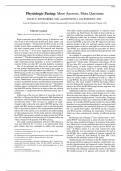1037
Physiologic Pacing: More Answers, More Questions
DAVID N. KENIGSBERG, M.D. and KENNETH A. ELLENBOGEN, M.D.
From the Department of Medicine, Virginia Commonwealth University Medical Center, Richmond, Virginia, USA
Editorial Comment with either smaller patient populations or relatively short-
term follow-up. Furthermore, the body of prior work has re-
“Happy is the one who can know the cause of things”
-Virgil
sulted in conflicting conclusions. One potential reason for
the differing results may be related to imprecise definition
Right ventricular apical (RVA) pacing is deleterious and of RVOT pacing sites contrasted with the more strict defini-
may result in left ventricular dysfunction, heart failure, and tion of the RVMS as the area of the RV adjacent to the most
increased mortality.1-5 Pacing from the RVA results in a left anterior borders of the low and high septum and the most
bundle branch block morphology, due to depolarization of posterior border of the low and high free wall in this article.
the right ventricle prior to the left ventricle and from the The RVMS was identified during the procedure by fluoro-
apex to the base.6,7 It has been suggested that pacing the scopic and ECG criteria and confirmed postoperatively with
heart in a manner closer to the normal physiologic pattern of echocardiography.
activation may reduce the incidence of these negative clinical An example of a prospective trial that set out to evaluate
outcomes.8,9 The determination of the best site(s) to pace has the benefit of alternative RV septal pacing sites as investigated
been a question that remains unanswered. Before we abandon by Muto et al. is the ROVA (Right ventricular outflow versus
right ventricular pacing altogether, it seems worthwhile to apical) trial.13 In this study, 103 patients with chronic AF and
consider if there are other RV sites that should be evaluated. EF less than 40% were randomly assigned to RVA pacing,
One of the potential sites that can be paced and results RVOT pacing, or both. Using a crossover design, patients
in near-normal depolarization of the heart is the septal as- were given each pacing mode for 3 months. After therapy,
pect of the right ventricular outflow tract (RVOT).10-12 Septal there was no difference in EF, hall walk distance, or quality
RVOT pacing results in a reduced QRS duration when com- of life measures between groups; there was, interestingly, a
pared with RVA pacing.13-17 This translates into a shorter ven- shorter QRS duration noted with RVOT pacing. In comparing
tricular activation time and possibly less ventricular dyssyn- these two similar studies with different results (i.e., Muto et
chrony. Furthermore, whereas RVA pacing has been shown to al. and ROVA), the most notable difference is the length of
result in myofibrillar disarray and detrimental ultrastructural follow-up. One must wonder if ROVA had longer follow-
changes, septal pacing in canine hearts does not.18 All of these up, how different the results may have been. The differences
findings suggest a potentially less harmful role of RVOT pac- between the RVA and RVMS groups became apparent only
ing than RVA pacing. However, in order to draw any clinical after 6 months in Muto’s report.
conclusions, a comparison between different pacing sites is Additional insight into a possible mechanistic explanation
needed. for these findings comes from a report from Lau et al. evalu-
In this issue of the Journal, Muto et al. report the results of ating the long-term effects of alternative RV pacing sites on
the Effect of Pacing the Right Ventricular Mid-Septum tract myocardial function and perfusion.20 In this study, 24 patients
in Patients with Permanent Atrial Fibrillation and Low Ejec- with complete heart block were randomized to RVA or RVOT
tion Fraction study.19 This retrospective analysis of single- pacing. At 6 months, RVOT pacing resulted in shorter QRS
chamber right ventricular mid-septal (RVMS) pacing com- duration, less myocardial perfusion defects, and regional wall
pared with RVA pacing in patients with an ejection fraction motion abnormalities, but similar EF. However, at 18 months,
(EF) of less than or equal to 30% and permanent atrial fibril- EF was significantly higher, with RVOT pacing compared
lation (AF) is the tipping point and aids in our understanding with RVA pacing, confirming the importance of long-term
of “physiologic pacing.” In this study, patients with pacing of follow-up when evaluating the benefits of different pacing
the RVMS experienced a significant improvement in NYHA sites.
class, EF, and quality of life measured at 18 months follow-up McGavigan and colleagues15 have reported that a “true”
when compared with patients with RVA pacing. septal RVOT lead placement is achieved only two-thirds of
This study’s patient population, with over 100 subjects in the time using standard techniques. In response to this prob-
each arm followed for 1.5 years, is an improvement from lem, Mond et al. recently published their novel curved stylet
prior studies that have attempted to address this question shaping technique to position a lead in the low RVOT sep-
tum.21 In Muto’s report, it is not clear exactly how many
J Cardiovasc Electrophysiol, Vol. 18, pp. 1037-1038, October 2007. times difficulty was encountered in positioning the lead in
the RVMS, but a certain number of patients required the
Dr. Ellenbogen received significant honoraria as well as other compensation LocatorTm system (St. Jude Medical, St. Paul, MN, USA)
for participation on a speaker’s bureau relevant to this topic. described in the methods section of the article.
Another pacing site of interest is the His bundle. His bun-
Address for correspondence: Kenneth A. Ellenbogen, M.D., Virginia Com-
dle pacing had been suggested to produce synchronous ven-
monwealth University Medical Center, PO Box 980053, Richmond, VA
23298-0053. Fax: 804.828.6082; E-mail: kellenbogen@pol.net or kael- tricular depolarization and improved cardiac function rela-
lenb@vcu.edu tive to RVA pacing acutely and in animal models. In 2000,
Deshmukh and colleagues reported the results of permanent
doi: 10.1111/j.1540-8167.2007.00948.x His bundle pacing in 18 patients with chronic AF, dilated




